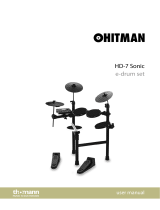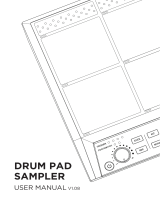
4
IMPORTANT NOTES
Power Supply
• Do not connect this unit to same electrical
outlet that is being used by an electrical
appliance that is controlled by an
inverter or a motor (such as a refrigerator,
washing machine, microwave oven, or
air conditioner). Depending on the way
in which the electrical appliance is used,
power supply noise may cause this unit
to malfunction or may produce audible
noise. If it is not practical to use a separate
electrical outlet, connect a power supply
noise lter between this unit and the
electrical outlet.
Placement
• Using the unit near power ampliers (or
other equipment containing large power
transformers) may induce hum. To alleviate
the problem, change the orientation of
this unit; or move it farther away from the
source of interference.
• This unit may interfere with radio and
television reception. Do not use this unit in
the vicinity of such receivers.
• Noise may be produced if wireless
communications devices, such as cell
phones, are operated in the vicinity of
this unit. Such noise could occur when
receiving or initiating a call, or while
conversing. Should you experience such
problems, you should relocate such
wireless devices so they are at a greater
distance from this unit, or switch them o.
• When moved from one location to
another where the temperature and/or
humidity is very dierent, water droplets
(condensation) may form inside the unit.
Damage or malfunction may result if you
attempt to use the unit in this condition.
Therefore, before using the unit, you must
allow it to stand for several hours, until the
condensation has completely evaporated.
• Depending on the material and
temperature of the surface on which you
place the unit, its rubber feet may discolor
or mar the surface.
• Do not place containers or anything else
containing liquid on top of this unit. Also,
whenever any liquid has been spilled on
the surface of this unit, be sure to promptly
wipe it away using a soft, dry cloth.
Maintenance
• Never use benzine, thinners, alcohol
or solvents of any kind, to avoid the
possibility of discoloration and/or
deformation.
Repairs and Data
• Before sending the unit away for repairs,
be sure to make a backup of the data
stored within it; or you may prefer to write
down the needed information. Although
we will do our utmost to preserve the data
stored in your unit when we carry out
repairs, in some cases, such as when the
memory section is physically damaged,
restoration of the stored content may be
impossible. Roland assumes no liability
concerning the restoration of any stored
content that has been lost.
Additional Precautions
• Any data stored within the unit can be lost
as the result of equipment failure, incorrect
operation, etc. To protect yourself against
the irretrievable loss of data, try to make
a habit of creating regular backups of the
data you’ve stored in the unit.
• Roland assumes no liability concerning the
restoration of any stored content that has
been lost.
• Use a reasonable amount of care when
using the unit’s buttons, sliders, or other
controls; and when using its jacks and
connectors. Rough handling can lead to
malfunctions.
• Never strike or apply strong pressure to the
display.
• When disconnecting all cables, grasp the
connector itself—never pull on the cable.
This way you will avoid causing shorts, or
damage to the cable’s internal elements.
• A small amount of heat will radiate from
the unit during normal operation.
• To avoid disturbing others nearby, try to
keep the unit’s volume at reasonable levels.
• Since sound vibrations can be transmitted
through oors and walls to a greater
degree than expected, take care not to
allow such sound to become a nuisance to
others nearby.
• The rubber portion of the striking surface
is treated with a preservative to maintain
its performance. With the passage of
time, this preservative may appear on the
surface as a white stain, or reveal how the
pads were struck during product testing.
This does not aect the performance or
functionality of the product, and you may
continue using it with condence.
• Continuous playing may cause dis-
coloration of the button and the knob, but
this will not aect the function.
• Do not use connection cables that contain
a built-in resistor.
Using External Memories
• Please observe the following precautions
when handling external memory devices.
Also, make sure to carefully observe all the
precautions that were supplied with the
external memory device.
• Do not remove the device while
reading/writing is in progress.
• To prevent damage from static electricity,
discharge all static electricity from your
person before handling the device.
• Some memory card types or memory cards
from some manufacturers may not record
or play back properly on the unit.
The memory card write protect feature (LOCK)
• The contents of the
memory card can be
protected by write
protecting it.
To write protect a card,
slide the write protect
switch on the side of the memory card to
the “LOCK” position. Unlock write protect
to delete data on the card.
• All memory cards eventually wear out. We
recommend that you consider the memory
card not as a permanent storage site,
but as a place to store data temporarily.
We also recommend that you back up
important data onto the another media
that is supported by your unit.
Intellectual Property Right
• It is forbidden by law to make an audio
recording, video recording, copy or
revision of a third party’s copyrighted work
(musical work, video work, broadcast, live
performance, or other work), whether
in whole or in part, and distribute, sell,
lease, perform, or broadcast it without the
permission of the copyright owner.
• Do not use this product for purposes that
could infringe on a copyright held by a
third party. We assume no responsibility
whatsoever with regard to any
infringements of third-party copyrights
arising through your use of this product.
• The copyright of content in this product
(the sound waveform data, style data,
accompaniment patterns, phrase data,
audio loops and image data) is reserved by
Roland Corporation.
• Purchasers of this product are permitted
to utilize said content (except song data
such as Demo Songs) for the creating,
performing, recording and distributing
original musical works.
• Purchasers of this product are NOT
permitted to extract said content in
original or modied form, for the purpose
of distributing recorded medium of said
content or making them available on a
computer network.
• MMP (Moore Microprocessor Portfolio)
refers to a patent portfolio concerned
with microprocessor architecture, which
was developed by Technology Properties
Limited (TPL). Roland has licensed this
technology from the TPL Group.
• MPEG Layer-3 audio compression
technology is licensed from Fraunhofer IIS
Corporation and THOMSON Multimedia
Corporation.
• The SD logo (
)
and SDHC logo (
)
are
trademarks of SD-3C, LLC.
• ASIO is a trademark and software of
Steinberg Media Technologies GmbH
• This product contains eParts integrated
software platform of eSOL Co.,Ltd. eParts is
a trademark of eSOL Co., Ltd. in Japan.
• This Product uses the Source Code of μT-
Kernel under T-License 2.0 granted by the
T-Engine Forum (www.tron.org).
• Roland, V-Drums, and BOSS are either
registered trademarks or trademarks of
Roland Corporation in the United States
and/or other countries.
• Company names and product names
appearing in this document are registered
trademarks or trademarks of their
respective owners.
Write protect switch





















